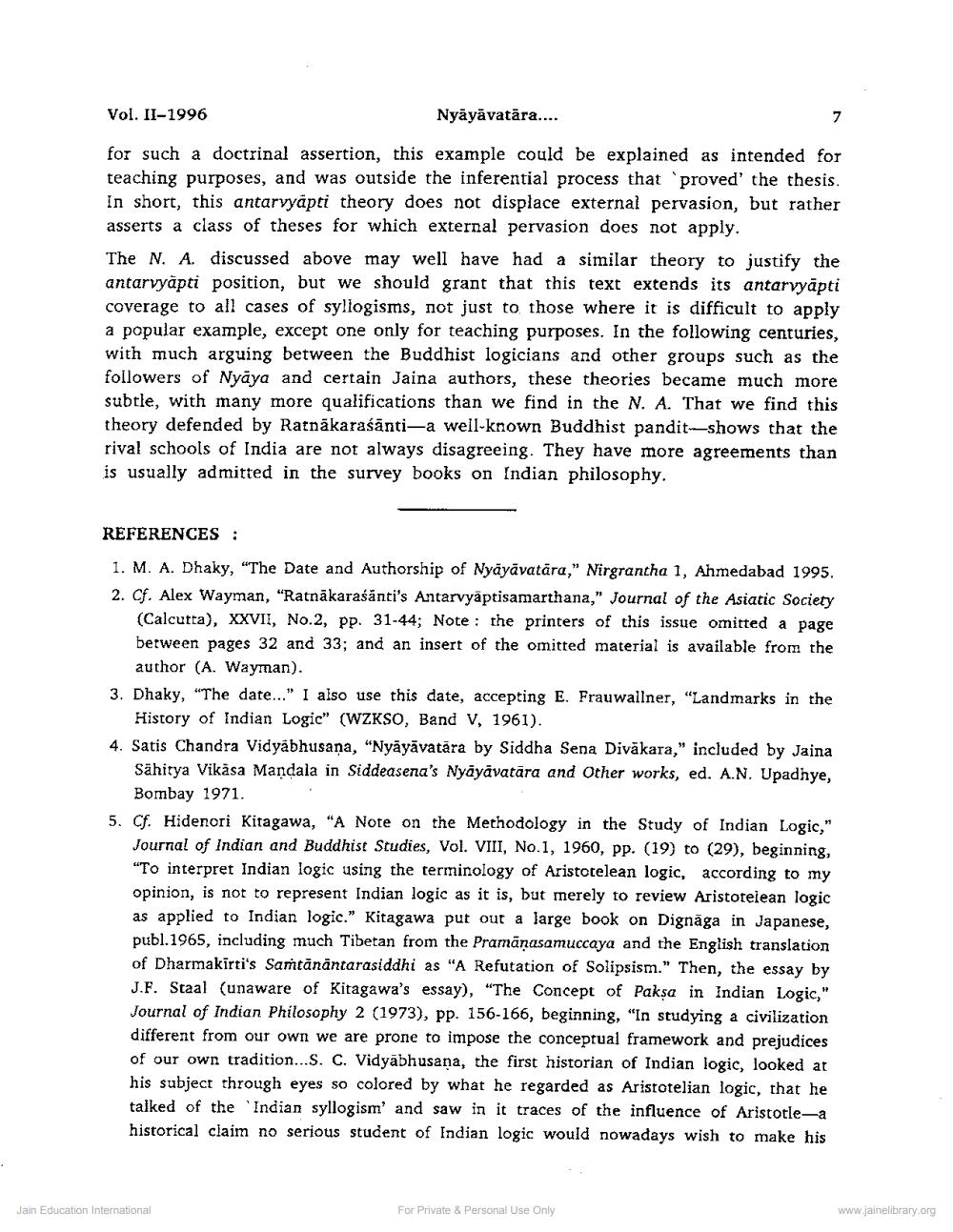Book Title: Nyayavatara and Buddhist Logical Works Author(s): Alex Wayman Publisher: Z_Nirgrantha_1_022701.pdf and Nirgrantha_2_022702.pdf and Nirgrantha_3_022703.pdf View full book textPage 7
________________ Vol. II-1996 Nyāyāvatāra.... for such a doctrinal assertion, this example could be explained as intended for teaching purposes, and was outside the inferential process that 'proved the thesis. In short, this antarvyäpti theory does not displace external pervasion, but rather asserts a class of theses for which external pervasion does not apply. The N. A. discussed above may well have had a similar theory to justify the antarvyāpti position, but we should grant that this text extends its antarvyāpti coverage to all cases of syllogisms, not just to those where it is difficult to apply a popular example, except one only for teaching purposes. In the following centuries, with much arguing between the Buddhist logicians and other groups such as the followers of Nyaya and certain Jaina authors, these theories became much more subtle, with many more qualifications than we find in the N. A. That we find this theory defended by Ratnakaraśānti-a well-known Buddhist pandit--shows that the rival schools of India are not always disagreeing. They have more agreements than is usually admitted in the survey books on Indian philosophy. REFERENCES : 1. M. A. Dhaky, "The Date and Authorship of Nyāyāvatāra," Nirgrantha 1, Ahmedabad 1995. 2. Cf. Alex Wayman, "Ratnākaraśānti's Antarvyāptisamarthana," Journal of the Asiatic Society (Calcutta), XXVII, No.2, pp. 31-44; Note: the printers of this issue omitted a page between pages 32 and 33; and an insert of the omitted material is available from the author (A. Wayman). 3. Dhaky, "The date..." I also use this date, accepting E. Frauwallner, "Landmarks in the History of Indian Logic" (WZKSO, Band V, 1961). 4. Satis Chandra Vidyabhusana, "Nyāyāvatāra by Siddha Sena Diväkara," included by Jaina Sähirya Vikasa Mandala in Siddeasena's Nyāyāvatāra and Other works, ed. A.N. Upadhye, Bombay 1971. 5. Cf. Hidenori Kitagawa, "A Note on the Methodology in the Study of Indian Logic," Journal of Indian and Buddhist Studies, Vol. VIII, No.1, 1960, pp. (19) to (29), beginning, "To interpret Indian logic using the terminology of Aristotelean logic, according to my opinion, is not to represent Indian logic as it is, but merely to review Aristotelean logic as applied to Indian logic." Kitagawa put out a large book on Dignāga in Japanese, publ. 1965, including much Tibetan from the Pramāṇasamuccaya and the English translation of Dharmakīrti's Sastānāntarasiddhi as "A Refutation of Solipsism." Then, the essay by J.F. Staal (unaware of Kitagawa's essay), "The Concept of Paksa in Indian Logic, Journal of Indian Philosophy 2 (1973), pp. 156-166, beginning, “In studying a civilization different from our own we are prone to impose the conceptual framework and prejudices of our own tradition...S. C. Vidyabhusana, the first historian of Indian logic, looked at his subject through eyes so colored by what he regarded as Aristotelian logic, that he talked of the Indian syllogism' and saw in it traces of the influence of Aristotle-a historical claim no serious student of Indian logic would nowadays wish to make his Jain Education International For Private & Personal Use Only www.jainelibrary.orgPage Navigation
1 ... 5 6 7 8
